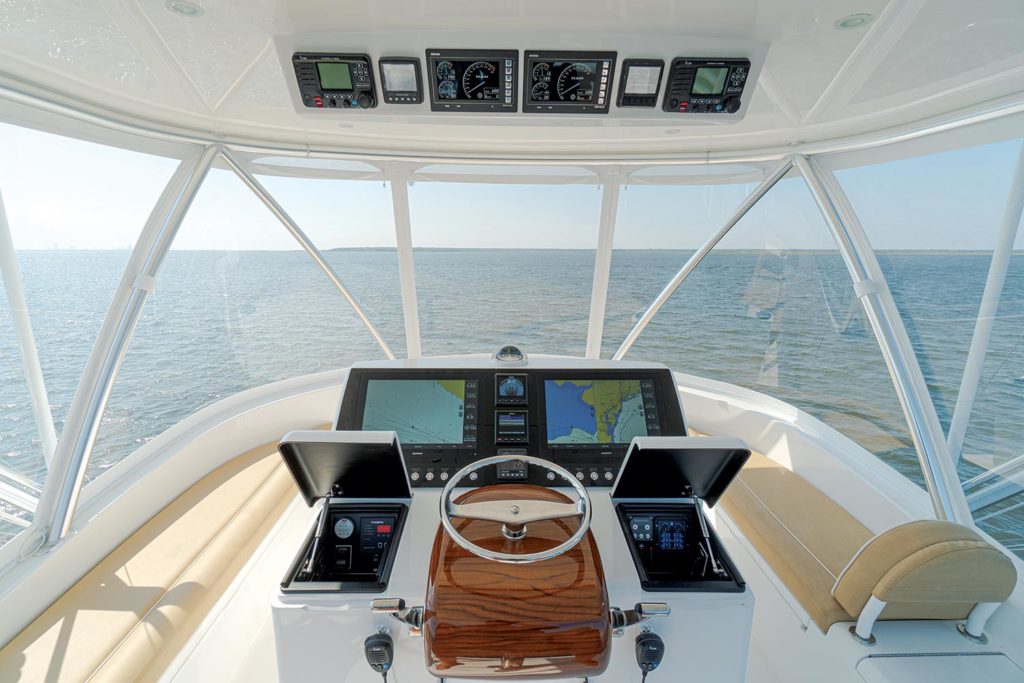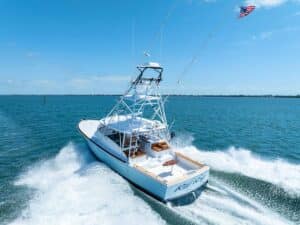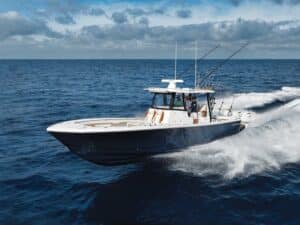Long before any sport-fishing boats were ever built in other parts of the East Coast, the sweet, cedar swamp waters of southern New Jersey produced a group of notable boatbuilders well-known for the robust construction of their vessels. Today, the most prolific production builder in the industry—Viking Yacht Company—continues to develop stylish, functional and fishy boats from its facilities along the winding and historic Bass and Mullica rivers.
I had the opportunity to review Hull No. 1 of the sporty new 46 Billfish. The boat embodies everything about a sport-fisher that makes them the effective tools we all yearn to fish with, while also taking aim at a segment of the market that has been virtually ignored for over the past decade. The team at Viking has developed the all-new design to open up that market, and they’ve hit the ball so far out of the park, the laces have been ripped off. The 46 Billfish takes the reins from its smaller siblings, the very successful 37 and 38 Billfish boats, with their open-bulkhead layout, clean dayboat styling and, for their size, massive cockpits.

But the thing I couldn’t get over was the ride. It was a great day to test a boat off the coast of Atlantic City, New Jersey, with a hard, southwest wind at 18 to 25 knots and a solid 3- to 5-foot confused sea, with an occasional 7-footer mixed in. We eased out of the inlet at 24 knots with a hard, outgoing tide, and could have easily been soaked and banged around, but the 46 loafed through it with no spray on the curtains and no fall-off between seas.

Performance
We had six aboard for the test: My lifelong fishing buddy, Capt. Gene Hawn; Viking ace Donnie Gemmell; John Leek IV, who oversees the Mullica River facility where the 46 is built; Viking’s director of communications, Chris Landry; commercial clammer and Viking 56 owner, Martin Truex; and Pat Healey, president and CEO of Viking—all salty guys who have a lot of time on the water. Everyone walked away equally impressed. There is a lot of room on the 46 in that we never felt overcrowded on the bridge or below.
Clearing the inlet, we pushed up the throttles, and as we asked for more speed, the boat gave it to us with similar results. Every time we expected to land hard or throw a giant spray, it didn’t happen, unlike so many other boats of this size—or any size for that matter. We turned and ran straight into the sea, in the trough, quartering, following—you name it, we did it, and in most at speeds of 26 to 28 knots in that slop. In the trough and down-sea, she easily scooted along at over 30 knots.
The only spray on the curtains came in the quartering sea as we turned away from the sea and wind. Most boats would have had spray over the hardtop with that much wind catching and carrying it aloft. Her SeaStar Optimus steering is very responsive and helps the boat turn without rudder blowout. She can spin on her own axis, back faster than anglers can wind, turn and run, then spin and back down with excellent response and agility. In other words, she’s got the juice to get it done in the bite.

Engine Room and Layout
Our test boat came powered with the upgraded pair of 800 hp MAN common-rail engines; the boat saw an average of 39.8 knots in two-way trials at wide-open throttle. There is no doubt that with prop tuning, the boat will easily see over 40 knots. I’m not so much wrapped up in speed though, because I appreciate a good economical cruise or slow, super-efficient chug a bit more. Naturally, many will see this open-bulkhead style as a dayboat or tender to a mothership, which she will more than fit the bill in either use, but there is no question that the boat is equally suited as a canyon-fishing and traveling rig as well.
Her Awlgrip-painted engine room is well-laid-out, with good access to all engine components for service, raw-water pumps, and oil and fuel filters. Our test boat had a standard five-point Reverso oil-change system, an upgraded Kohler 16 kW generator aft of the starboard engine and a Seakeeper SK6, which is mounted on the centerline. Access is through the centerline deck hatch.

Belowdecks, the 46 Billfish is laid out similar to many express-style boats. Available in two layouts, the difference being in the forward stateroom, the optional Plan B offering is a full-size berth to port with storage beneath and a single upper berth to starboard; our test boat had the standard layout with a full queen island berth.
Aft of the master stateroom is the open area with upper and lower bunks, along with a full head on the aft bulkhead to port. The head has a full shower, Corian countertops, vanity and undersink cabinet with storage. To starboard is the full galley with electric two-burner recessed stove, microwave/convection oven, stainless sink and undercounter refrigerator, freezer drawers, built-in ice maker, and storage cabinets overhead. The main electrical distribution panel is in a galley overhead cabinet along the aft bulkhead. The upper-command-deck door is on the centerline.
Read Next: Viking celebrated its 50th anniversary in 2016.
The upper command deck is simple and clean, with bench seating to starboard with rod storage, as well as a full length, U-shaped dinette lounge to port with a high-low table. These benches also have hydraulic rams for complete access to the engine room.

Cockpit and Helm
The 46 Billfish cockpit is enormous for its class at 140 square feet. It is one of the many endearing qualities and an obvious nod to the serious fishability designed into the boat. She features a pair of cavernous in-deck insulated fish boxes to port and starboard. Among the many notable accessories are a large molded livewell and walk-through tuna door in the transom, dockside water, a 50-amp power inlet, and full mezzanine. The port mezzanine seat contains a freezer and insulated storage under the step. In the starboard mezzanine, there is a tackle center with drawers under the seat and refrigerated storage in the step.
The bridge is ample with a walk-around center-console helm station with a seat in front and a Release Marine helm chair, with bench seating to port and starboard and storage beneath. The centerline teak helm pod with single-lever controls has an electronics panel in front with room for two large multifunction displays. There are equipment boxes on each side of the helm for ancillary equipment as well.
Read Next: Read our interview with Viking Yachts president Pat Healey.
The 46 Billfish fills a niche long set aside in the sport-fishing world. This boat is fully capable in any discipline of gamefishing and will be sought out by those who are serious about their methods of angling. The folks on the Bass and Mullica rivers have done their homework and research, and have delivered an excellent product.
Viking 46 Billfish Specs
- LOA: 45′6″
- Beam: 15′4″
- Draft: 4.3′
- Displ: 43,134 lb.
- Fuel: 709 gal.
- Water: 99 gal.
- Power: Twin Man 800 HP
- Propellers: acme, 4-blade
- Paint: Antifouling-Interlux
- Climate Control: Dometic











